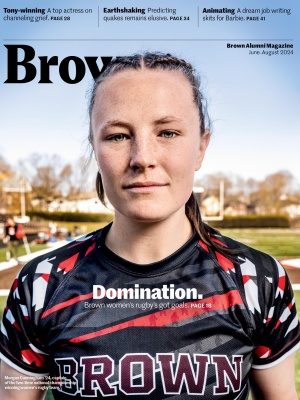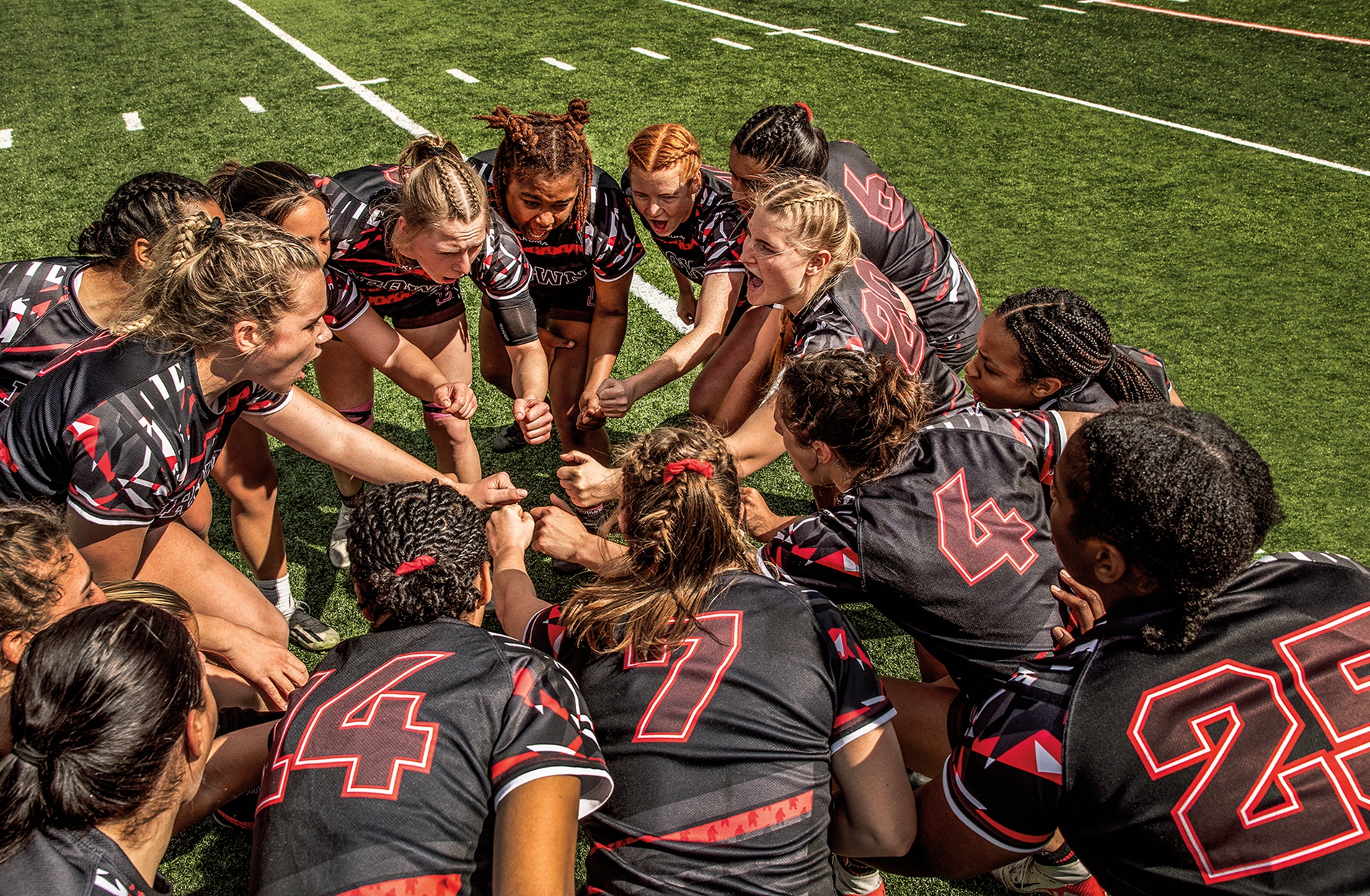
Unrelenting
What a championship-winning team knows about love, loss, and rugby
If there’s one thing to know about the Brown Rugby team, it’s that its members love the Brown Rugby team. In fact, it’s a truth so universally acknowledged amongst the Division 1 team’s players that it’s become the program’s signature cheer. “I LOVE,” Morgan Cunningham ’24, the team’s captain, often yells. “THIS TEAM,” the other players will reply in unison.
It’s a lovefest that’s driven victories on the pitch. Last April, the players secured the program’s first Women’s Premier Collegiate Rugby National 7s Championship title after a nail-biting 21-19 victory over Army. Fast forward to the following October: now in the back half of the fall 15s season, the team is gearing up for another home game tomorrow during Brown’s annual Family Weekend. This time they’re up against Penn State, one of the most competitive teams in Division 1.
It’s 63 and sunny when the team gathers at the Berylson Family Fields: at least for the next several hours of practice, the players are preparing for war. At 3:15 on the dot, a voice interrupts Fleetwood Mac, whose album has been blasting during the warmup. Short, resolute, and smiley, Head Coach Rosalind Chou is dressed for today’s practice in a Brown T-shirt and white baseball cap.
“Come on in, everybody,” she shouts, as the players begin gathering around. A Brown professor of sociology now in the tenth year of her coaching career, Coach Chou knows a thing or two about group dynamics—in the classroom, in the locker room, on the pitch. And with “Go Your Own Way” now paused, today’s practice can officially begin.
For the most part, rugby lives up to its image—rowdy players, tackles, mud. Earlier in the week, forwards prepped for offense with Assistant Coach Kittery Wagner Ruiz while frequently yelling the word domination! Meanwhile, backs worked on defensive skills with Assistant Coach Bridget Kahele, donning mouth guards to brace for collisions.
Beyond domination, however, rugby’s extreme physicality also requires the absolute focus of its players—their complete synchronization—to succeed. Rugby is the only full contact sport to have the exact same rules for men and women. As a result, players put their bodies on the line for their teammates; vulnerability is the fabric of the game. This intensity breeds a certain bond, Brown’s players will tell you. One that extends far beyond the pitch.
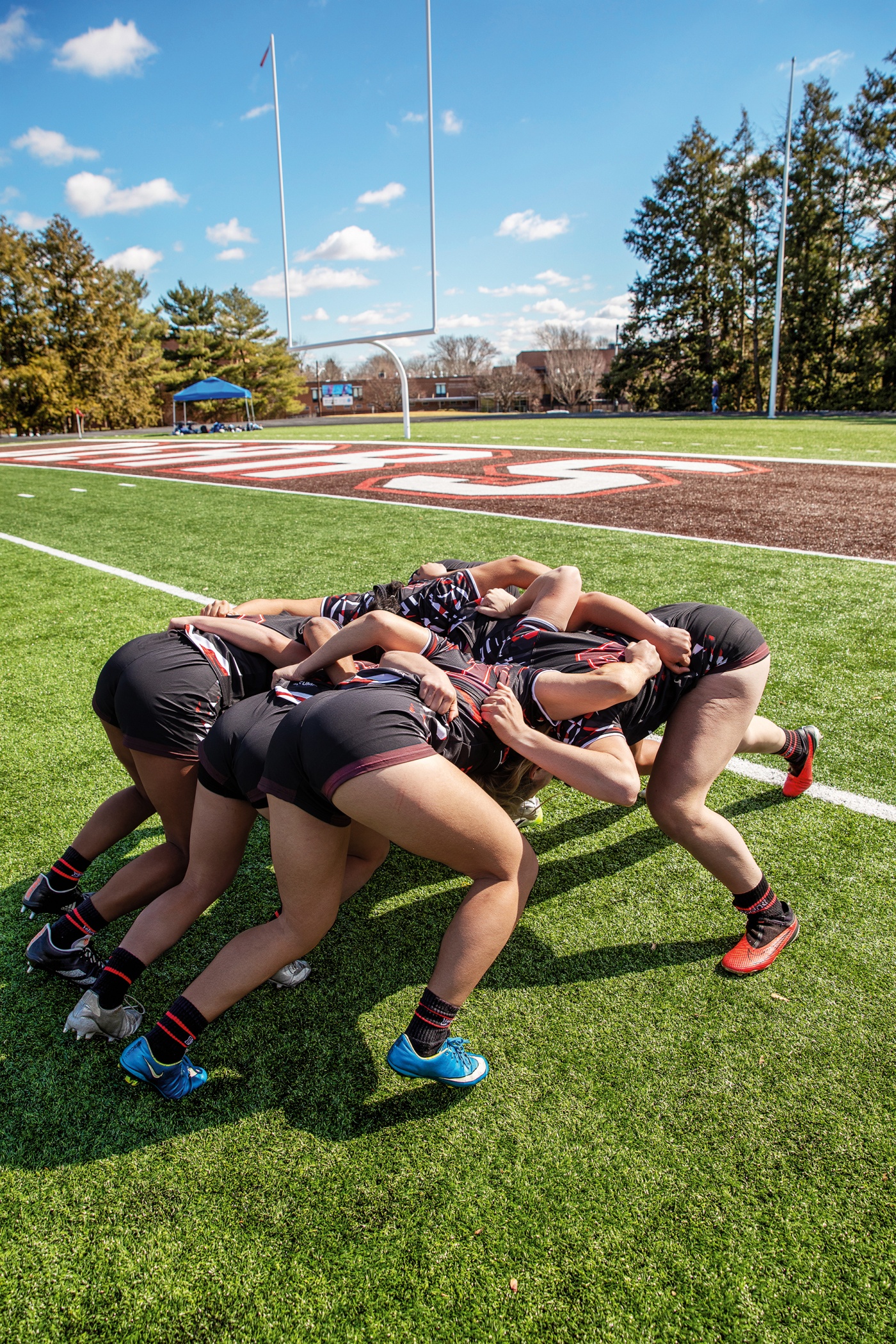
Feel Hard, Work Harder
There’s a lot of crying in rugby.
In fact, during the season, you can expect the Brown varsity women’s rugby team to host a good communal cry session approximately once a week, typically on the eve of each game. This Friday is no different. It’s about an hour after practice when the team reconvenes inside the Olney-Margolies Athletic Center. Yet again, Coach Chou calls her players to attention: it’s time for the jersey ceremony.
The ceremony has become a bit of a weekly ritual for the team, stemming from an old rugby tradition. Unlike most team sports, in rugby, each number corresponds to a position, not a player. Nobody’s name is on the back of a jersey, Coach Chou explains to a group of visiting parents. You don’t own your jersey; you have to earn it each week.
There is a singular exception, however: Flores, number 8.
It’s the name and number printed on each player’s warmup jersey, which the team wears to each weekend’s game. This is because, as the team’s players, coaches, and alumnae will often tell you, former head coach Kathy Flores unequivocally remains the beating heart of Brown rugby: as a coach, as a mentor, as a friend, even as the namesake for the head coach’s official title. It was Flores, a star player at the first Women’s Rugby World Cup in 1991 and former head coach of the U.S. women’s national team, who oversaw Brown women’s rugby’s transition from club to varsity status when she first joined the program in 2013. She served as head coach for the next eight years, even during her year-long battle with colon cancer. Flores passed away from the disease in October 2021 at 66. Now, two years later, her legacy remains ever-present; among players, “For Kathy” is a mantra.
During the jersey ceremony each week, the players typically honor a chosen theme. Last week was dedicated to LGBTQ+ pride, while next week’s gathering will commemorate the anniversary of Flores’s death. (“Sometimes you’re just crying for half an hour,” Chou tells me.) In the varsity lounge this afternoon, however, the players’ moods lean lively. Today’s ceremony is a nod to Family Weekend. One by one, each player is called forward to say a word that encompasses what family means to them.
THE SCRUM IS LESS than a minute of pure, concentrated effort. Beyond force, it’s a contest of balance. “We try to emulate each other’s energy and become not eight people but one.”
“Synergy,” says one player. “Presence,” says another. Acceptance. Loyalty. Purpose. Each time a new player goes up to share, the room explodes with a chorus of shouted nicknames, cheers, and applause. Crying or laughing—on the pitch or on the sidelines—Brown rugby is a team that feels, hard.
“No one cares, work harder,” reads the text on the back of each warmup jersey—a classic Flores quote, and Brown rugby’s general approach to the game.
Bring Your Strength, Not Your Diet
Earlier that week, I spent a large portion of Tuesday’s practice sitting in the end zone with a group of players I’d heard Emme Ohnmacht ’25, the team’s manager, lovingly refer to as the “injury squad.” For a sport as physically demanding as rugby, injuries are somewhat to be expected. They’re part of what keeps Nyrel Stroup, the team’s athletic trainer, so busy. (Injuries also keep the job exciting, he tells me—for him, it’s rugby or he’ll walk.)
While most players on the team are lifelong athletes, they’re not necessarily lifelong rugby players. For one player, before rugby it was field hockey; for another it was dance. One played soccer, one ran track, and another competed in figure skating. Students in the U.S.—particularly women—aren’t often exposed to rugby early on. It’s why most players, even some of the best in the country, come to rugby relatively late.
This is a unique position for a D1 varsity team. Most of the team’s recruited athletes have been playing for only a few years, and the rest of the team joined the program as walk-ons, many of whom hadn’t played rugby before coming to Brown. “Imagine asking someone to join the swim team who’s never swum before—to be an NCAA Division 1 swimmer,” Chou says. “You’d drown, right?”
But it’s exactly that “walk-on mentality” that defines the ethos of the sport, Coach Chou argues. Case in point: Trinity Williams ’26 never envisioned herself playing a sport in college, much less playing rugby. But then classmate Noelle Lewis ’24 introduced her to the game. “I’m five-one. I have never done any kind of contact sport in my life,” Williams remembers telling her. But Lewis reassured her that rugby, as Coach Chou says, is for everyone: there’s a position designed for each build of player. Wings like Williams tend to be short and fast. Props are generally large and commanding. Locks skew muscular and tall.

“You could be tall, you can be shorter, you could be slim, you could be muscular,” says Coach Chou. “Everybody is celebrated in rugby.” For all players, physical strength is viewed as an asset, rather than something to be feared. It’s a fact that’s particularly meaningful for college-aged women, a group that often receives the opposite message. Up to 84 percent of college athletes report engaging in disordered eating behaviors; among female athletes in particular, this mindset disproportionately manifests as restriction.
“We challenge all these things because if you’re gonna win a collision, you need as much weight as possible,” says Chou. “You need as much muscle as possible.” In rugby, players are valuable because of their size, not in spite of it.
The sport’s full-contact nature requires players to consistently push the boundaries of their athleticism, to build up their capabilities to new heights. Rugby is a chance to do something hard every day, Williams tells me during Tuesday’s practice. For players of all sizes, the emphasis is on gaining strength, building skill, and digging deep.
Today’s walk-on philosophy isn’t so different from how things were in the beginning. Brown’s first club women’s rugby team was founded in the 1970s. “You don’t have to weigh 300 pounds, be monosyllabic, have a heavy voice, and drink beer for breakfast,” club captain Clare Pouncey ’87 told the Brown Daily Herald in 1985. “But if someone like that came out, we’d take them.”
Scrums and Crockpots
It’s early on Saturday morning when the players return to the Berylson Family Fields. It’s yet another remarkably sunny day on College Hill, while overnight the air has grown crisp. On the walk towards the bleachers, the Brown band can be heard warming up in the distance, practicing for the football game that will take place later that day.
Just past the end zone, I spot a group of parents setting up for yet another weekly ritual, this time a global rugby tradition dating back to some of the earliest days of the sport: the post-game meal. Over the years, it’s become customary for opposing teams to share a meal together after each match, Jania Vandevoorde ’25 explains. “During those 80 minutes when we’re playing them, it’s a war,” she says. “But after we finish, we’re best friends with them.”
“IF YOU’RE GONNA WIN a collision, you need as much weight as possible... You need as much muscle as possible.” In rugby, players are valuable because of their size, not in spite of it.
There on the field I first meet Erinn Harley-Lewis, holding onto a massive bowl of pasta salad. The mother of senior Noelle, Harley-Lewis is the official unofficial rugby team mom, who spearheads culinary preparations for each home game with the help of Terry Mahoney, the dad of junior Elizabeth. There is one slight complication. Harley-Lewis and her family live in Northern Virginia, approximately 425 miles from Providence. It hasn’t stopped her yet.
During the season, Harley-Lewis leaves Virginia on Thursday nights to make the drive up I-95 towards New England with a car full of pre-prepped ingredients (if she gets lucky enough to beat traffic, the drive can be done in seven hours, but most of the time it takes eight). The main prep begins on Friday. Harley-Lewis sometimes slow-cooks meat throughout the night, or wakes up at three or four the following morning to prepare enough food to feed two hungry rugby teams, their families, and spectators—all in her hotel room kitchenette.
With the preparations for today’s feast now securely stashed past the end zone, the game can officially begin. It isn’t yet five minutes after kickoff when the players first set up for a scrum.
The scrum is a defining feature of rugby: the “little wrestling match” that restarts play, often after the ball is fumbled forwards, Nat Phonwiang ’27 explains (in rugby, the ball can legally be passed backward only). When a scrum is called, eight players from each team weave together to form two massive opposing huddles, with two players, called hookers, at the helm. The ball is then dropped between them, prompting each group to press forward in an attempt to push the opposing team back.
The scrum is less than a minute of pure, concentrated effort. Beyond force, it’s a contest of balance. “We try to emulate each other’s energy and become not eight people but one,” explains Vandevoorde. “One plus one equals three,” adds Nikki Lynch ’24. Teamwork is more than just an athletic strategy, the players argue; coaction is the essence of the game.
“There is a culture of family in all rugby,” says Coach Kitt. It’s intensely combative, but rugby is also defined by camaraderie. Even today, the world of women’s rugby is small, and it’s not uncommon for players to know several members of the opposing team during matches. The relative insularity has allowed the sport’s customs to thrive behind the scenes.
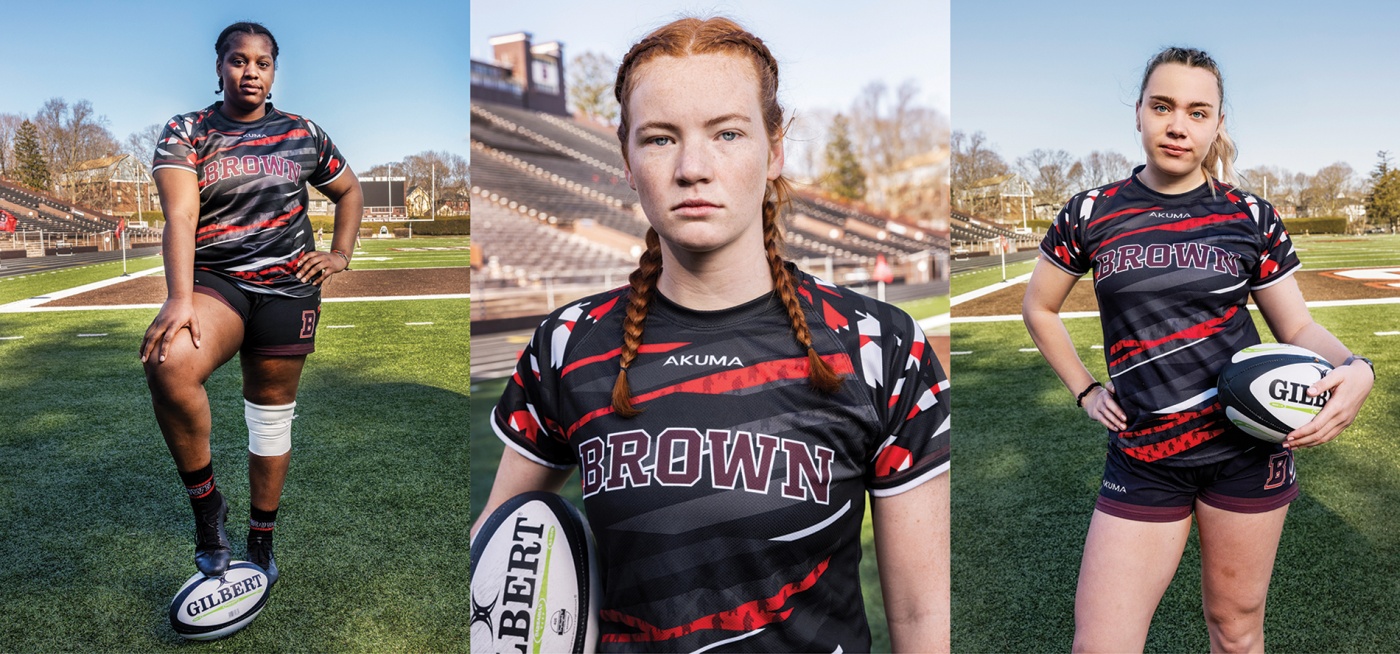
For Coach Chou, the come-as-you-are mindset was one of the first things to attract her to the game, along with rugby’s reputation as a hub of queer culture. When Chou first began college as a member of the Florida State softball team, she recalls a level of normalized secrecy—an expectation to keep your sexuality hidden. “People painfully hiding who they were, not wanting to come out,” she recalls.
That all changed when she joined the FSU rugby team as a junior. Her first coach was openly out as gay, and so were many of her teammates. As a young, questioning queer person at a time when LGBTQ+ acceptance was far from widespread, this form of open representation was world-shifting. Her experience isn’t unique—rugby has historically had a prominent queer presence, and on the international level, there’s a long tradition of forming explicitly gay rugby teams. “Everything’s gay about rugby,” Phonwiang laughs. “On previous teams, I had trouble finding people who were like me and when I came to rugby they immediately clocked me.”
Players of all sexual orientations have long had to counter gendered expectations. After all, rugby is far from traditionally feminine. The first recorded women’s rugby matches date back to the mid-19th century. Even in 1991, however, the first women’s Rugby World Cup received no official backing from the International Rugby Board, and the winning U.S. national team had to design and sell T-shirts to help cover the tournament’s expenses. Long ignored—or disregarded as spectacle—recognition has often come late for women’s rugby players. It wasn’t until 2009 that the board officially acknowledged the ’91 World Cup, and not until 2014 that the first woman was inducted into the World Rugby Hall of Fame. (Flores was inducted posthumously in 2022.)
For Brown’s players, standing in opposition to this history can itself be a motivating factor. “You always get that eyebrow raise,” says Lynch. “I think that’s really what motivates me.” The more mainstream recognition women’s rugby attracts, particularly on the professional level, the more women become exposed to the game. World Rugby notes that a quarter of players globally are women, up 53 percent in the past year.
THIS INTENSITY REQUIRES a baseline of trust, the players argue. It all comes back to that common refrain. “We’re literally putting our bodies on the line for each other every single day at practice,” says Vandevoorde.
Better Humans
Coach Chou’s academic work forms the foundation of her coaching philosophy. As a critical race theory scholar currently writing a book about the queer experience on college campuses, there aren’t many boundaries between the issues her players experience in real life and the academic theories she teaches in the classroom. While coaching at Life University, she and her students led protests against the anti-trans “bathroom bills” being proposed in Florida at the time. At Brown, the coaches have made it a point not to hide their queer identities or shy away from difficult conversations as a team—whether it’s women’s health, the 2021 Atlanta spa shootings, or the murder of George Floyd. “Coaching is teaching, teaching is coaching,” she says. And the wider world is the center of both.
It’s another lesson that comes back to Flores.
“Kathy understood where I was coming from and how it was going to be a big transition,” says Akilah Cathey ’25, whom Flores recruited to the team. A sought-after player in high school, Cathey was weighing a few competitive recruitment offers. But it was Flores who made Brown stand out. The two talked candidly about race and identity—and how students of color like Cathey often struggle to find space at predominantly white institutions such as Brown, and as players within the wider world of rugby. “First you get that rugby is a white sport and then you get that rugby is a male-dominated sport,” Cathey explains.
When Cathey first came to Brown, Flores, who was of Filipino and Hawaiian descent, encouraged her to connect with the Third World Transition Program, an orientation program led by the Brown Center for Students of Color. “It’s good to see people look like you,” Flores told her at the time. “Just because you’re at a PWI [predominantly white institution] doesn’t mean you should hide your identity.” Today, Cathey pays this mentorship forward by being a voice for younger players, particularly those of color, who join the program. “The people of color on the team, we truly have our own community and our own support,” says Williams.
Having grown up as the only Asian student on her high-school basketball and softball teams, Coach Chou has experienced this same isolation first-hand. And just as for Flores, it now informs her strategy as a coach. Since gaining varsity status, Brown’s coaches have used the program’s additional funding and recruiting capacity to increase the racial and socioeconomic diversity of Brown’s team over the past decade. Beyond the roster, Coach Chou is thoughtful about how she shapes the team’s culture. “I want you to be a better human being off the field and I also want you to be a better human being on the field, to your teammates,” she says. “The more you have this space of support, the better your team’s going to be, whether you win on the scoreboard or not.”
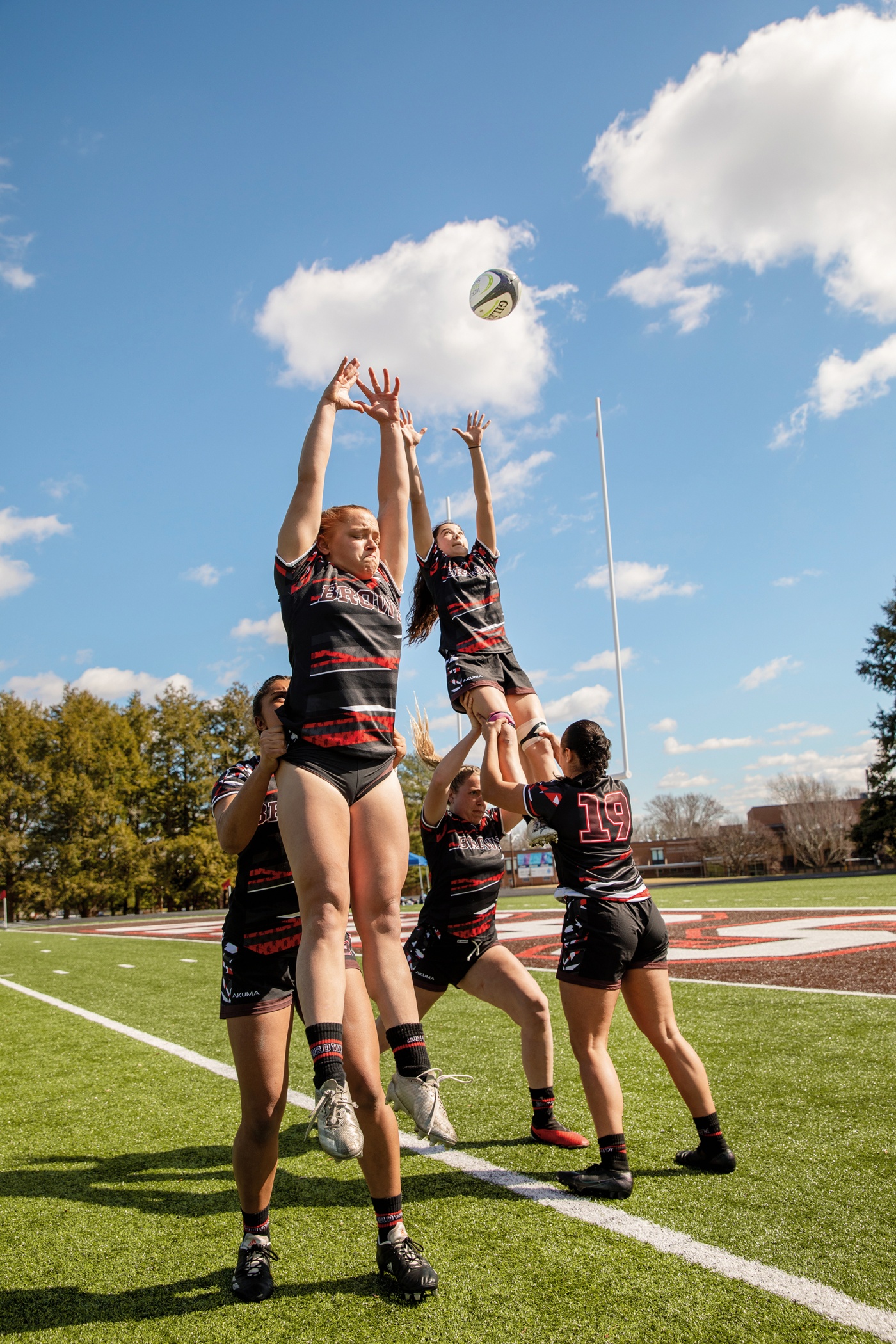
Bodies in Motion
The team is down 10-5 at halftime, and the air on the sidelines is tense. “Think of two things you want to do differently in this half than the last half,” Captain Cunningham tells her teammates before the second half begins. As she chants “Triple B on three,” each player sticks a hand in the huddle. “BOLD, BEAUTIFUL BEASTS OF BROWN,” the team replies, before running back onto the pitch.
Beautiful rugby means thinking strategically, Cunningham later tells me: thinking smart, playing proud, hitting low. Good tackles are low tackles, Coach Chou adds: “If you are lower and have a lower center of gravity, you’ll also have a better collision.”
Weathering tackles isn’t just a contest of strength, however—players need agility, strategy, endurance, and speed. In football, when a player goes down, the entire stadium pauses. In rugby, everyone else keeps vying for the ball. That means when a player is tackled, she needs to know how to fall. The goal, Coach Chou explains, is to remain moving when you catch the ball; this prepares you to fall forward, which pushes the defending team back. “When we’re talking about physics and bodies in motion, you know the one that’s static is going to lose,” says Chou.
In order to perfect this strategy, you want the hardest tackles to come from your teammates during practice—not from the opposing team during games. And that kind of intensity requires a baseline of trust, the players say. It all comes down to a common refrain. “It’s about putting your body on the line for the person next to you,” says Cunningham on one occasion. “We’re literally putting our bodies on the line for each other every single day at practice,” says Vandevoorde on another. “You are putting your life on the line in some ways, and these people become your closest family,” Coach Chou tells me. The Brown rugby team, it seems, speaks a shared language, and on the pitch it hits with one arm. When that whistle blows, each player goes into battle knowing her teammates are there by her side.
It’s less than five minutes into the second half when Akilah Cathey ties up the game. This time, it’s the crowd in the stands that explodes.
Sarah McGrath ’24 was a senior editor at the Brown Political Review. She just completed a nonfiction writing honors thesis chronicling the rise and (relative) fall of BuzzFeed. She is not particularly athletic.

